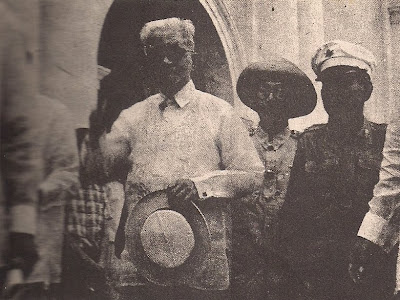
Emilio Aguinaldo
(1869-1964; President 1898-1901)
First President of the First Republic of the Philippines
“We may be losing our hope to succeed in the present battle because of lack of warfare manpower, however what we cannot lose is our hope to die for the sake of freedom.”
Emilio Aguinaldo, the first President of the First Republic was born in Kawit, Cavite on March 22, 1869. His father is Carlos Aguinaldo and his mother is Trinidad Famy y Valero.
Emilio was nicknamed Miong. At age three, he almost died because he became ill of smallpox and his parents were afraid of his condition.
Miong’s first teacher was his aunt Sotera. He first attended school at the National School in Kawit, and his first teacher is Felipe Canda of Baliuag, Bulacan. Miong is a bright student and likes to study which makes his teacher fond of him.
He continued his studies at San Juan de Letran College. After three months, he went home and quit his studies. Upon his return to his hometown, he was appointed as Cabesa de Barangay or Village Chieftain and it wasn’t long because of his great leadership skill, that he was invited by a friend, Santiago Alvarez to join Katipunan. The Katipunan is a secret organization of Filipinos who were against the grave abuse of power of the Spanish government in the Philippines. This organization also started the revolution against the Spanish. The Katipuneros, including Emilio Aguinaldo revolted against the Spaniards in 1896. Because of his bravery and valor, he led the revolt and he became the President in Tejeros convention because of a conspiracy and his persuasion of the officials and leaders to vote for him instead of Bonifacio because Aguinaldo said that Bonifacio has no formal education, illiterate and poor.
In the said convention, Emilio Aguinaldo have said: “My Filipino countrymen, open your eyes. Let the blood of our fellow Filipino that was oppressed by the Spanish lingers in your hearts so that we may not surrender to the Spaniards. We haven’t committed any wrongdoings to not obtain freedom.”
Aguinaldo ordered the execution of his biggest rival, Bonifacio brothers, Andres and Procopio at Mt. Buntis, Maragondon, Cavite on May 10, 1897.
After the pact in Biak-na-Bato, the Filipinos and the Spanish agreed to halt the war. The treaty were to obliged the Spanish government to forgive the Filipino revolutionist. It is also obligatory for the Spanish to pay in the amount of one million, seven hundred thousand pesos (P1,700,000) for te damaged properties during the revolution.
Emilio Aguinaldo and other Filipino leaders escaped to Hong Kong. Gen. Emilio Aguinaldo deposited one million, seven hundred thousand pesos, paid by the Spanish government to the Filipinos, in Hong Kong and Shanghai Bank on January 2, 1898. However, the Spanish betrayed and followed the treaties in Biak na Bato (Halved Stones). Filipinos too advantage of the Spanish-American War in Cuba. They have decided to return to the Philippines and continue the movement for freedom. Gen. Aguinaldo made connections with the Americans. He had entrusted to the American consulate in Hong Kong, the amount used to purchase arms and weapons. However, Gen. Aguinaldo was deceived again. No help came from the Americans.
Upon Gen. Aguinaldo’s return to the Philippines on May, 1898, a battle between the Filipinos and the Spanish erupted. Aguinaldo successfully declared the Philippine Independence on June 12, 1898 in Kawit, Cavite. On this occasion, as the First President of First Republic, Emilio Aguinaldo uttered:
“We are free now. We don’t just obey. We are people who recognize the law, make friends and respect other countries. We have enough abilities to be independent and to be fee.” I am congratulating all the Filipinos. From now on, we already have our own rights to freedom to be known as the “Republic of the Philippines.”
President Aguinaldo appointed Felipe Agoncillo to be the Philippine representative in United States. Agoncillo tried to talk with President McKinley but he failed. The Americans ignored the desire of the Filipinos to recognize the Philippines as a free country. Instead, on December 10, 1898, in the Treaty of Paris between Spain and the United States, the Philippines was ceded to the United States by Spain in the amount of twenty million dollars ($20,000,000).
The Filipinos started killing Americans in the Philippines. The Americans thought that in the amount they gave to Spain, they will capture the hearts and minds of the Filipinos. Aguinaldo tries to stop the war. Due to lack of skill and power, Filipinos were easily defeated by the Americans. During the battle of Tirad Pass in Ilocos Norte province on December 1899, Gen. Aguinaldo narrowly escapes the tragic battle of the Filipinos against Americans by heeding the warning of one of his troops not to come to the losing battle.
Finally, Aguinaldo captured by the Americans on March 23, 1901 in Palanan, Isabela. He was made to swear allegiance to America on April 1, 1901.
In 1935, President Aguinaldo run for election as President of a Commonwealth government. His opponents include Manuel L. Quezon and Gregorio Aglipay. Aguinaldo was easily defeated and the presidency was won by Manuel L. Quezon.
When the Japanese occupied Philippines in 1941, Aguinaldo doesn’t have enough strength to lead. Through radio transmitter, he made announcements to Gen. Douglas MacArthur on February 6, 1942 to surrender the Philippines to Japan to avoid the increase in casualties of Filipinos and damage of properties. President Aguinaldo is one of the signatories of the Constitution of the Republic under Japan.
Aguinaldo’s first wife is Hilaria del Rosario with which he has five children namely Miguel, Carmen, Maria, Emilio and Cristina. Nine years after his wife’s death, President Aguinaldo remarried and his second wife is Maria Agoncillo. President Emilio Aguinaldo died on February 6, 1964.
Major World Events During Aguinaldo’s Administration
Netherlands. First Hague Peace Conference, 1899
China. Boxer uprising against foreign domination, 1900
Australia. Commonwealth of Australia established, 1901
South Africa. Boer War 1899 – 1902




















